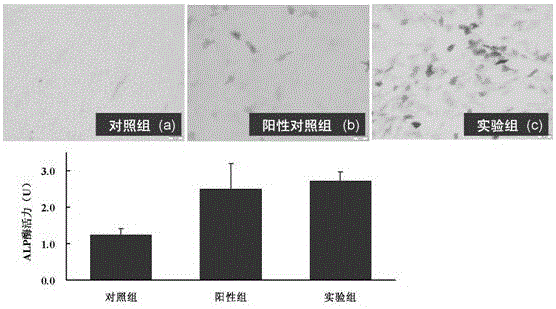Method for improving osteogenic differentiation efficiency of human amniotic mesenchymal stem cells and application thereof
A technology for stem cell and osteogenic differentiation, applied in biochemical equipment and methods, animal cells, vertebrate cells, etc., can solve the problem of undiscovered human-derived factor stem cells, etc., to improve the efficiency of osteogenic differentiation and promote expression. and activity, the effect of avoiding the difficulty of osteoblasts
- Summary
- Abstract
- Description
- Claims
- Application Information
AI Technical Summary
Problems solved by technology
Method used
Image
Examples
Embodiment 1
[0022] Example 1: Method and Application of Improving Osteogenic Differentiation Efficiency of Human Amniotic Mesenchymal Stem Cells
[0023] 1. Isolation and culture of human amniotic mesenchymal stem cells
[0024] The amniotic membrane was bluntly removed from the fresh placenta of healthy full-term cesarean section, and the amniotic membrane was washed with D-Hank's solution containing 1% double antibody (final concentration: penicillin: 100 IU / mL, streptomycin: 100 IU / mL, fresh before use). Preparation) repeatedly rinse the amniotic membrane to remove residual blood stains and surface mucus. Cut the amniotic membrane into 1-3 cm 2 Divide into 50 mL centrifuge tubes, add 0.05% trypsin digestion solution containing 0.02% EDTA-2Na about 2 times the volume of amnion tissue, and digest in a constant temperature water bath at 35-37 ℃ at 150-185rpm for about 30 minutes , after filtering through a 300-mesh stainless steel filter, discard the digestion solution containing amniot...
Embodiment 2
[0031] Example 2. The use of human amniotic mesenchymal stem cells to promote osteogenesis in other aspects
[0032] Human amniotic mesenchymal stem cells are induced to differentiate into osteoblasts in vitro by the induction composition of the present invention, and can be used as seed cells for bone tissue engineering and cell transplantation. It has a certain preventive effect on fractures and bone metabolic diseases. Using the induction composition of the present invention to induce differentiation of human amniotic mesenchymal stem cells as seed cells to replace osteoblasts can avoid the problems of difficult acquisition of osteoblasts in vitro and high immunogenicity.
PUM
 Login to View More
Login to View More Abstract
Description
Claims
Application Information
 Login to View More
Login to View More - R&D
- Intellectual Property
- Life Sciences
- Materials
- Tech Scout
- Unparalleled Data Quality
- Higher Quality Content
- 60% Fewer Hallucinations
Browse by: Latest US Patents, China's latest patents, Technical Efficacy Thesaurus, Application Domain, Technology Topic, Popular Technical Reports.
© 2025 PatSnap. All rights reserved.Legal|Privacy policy|Modern Slavery Act Transparency Statement|Sitemap|About US| Contact US: help@patsnap.com



